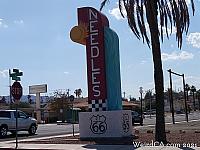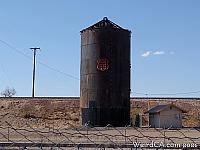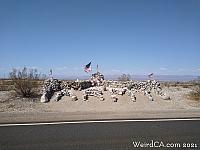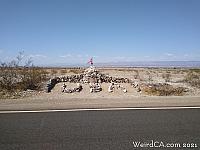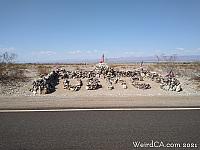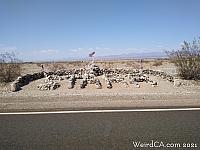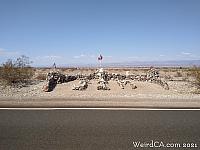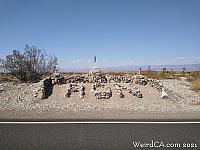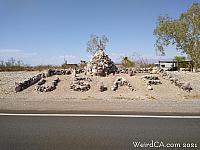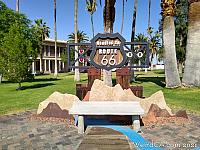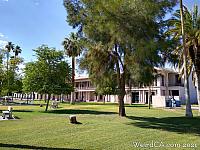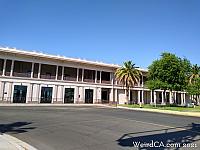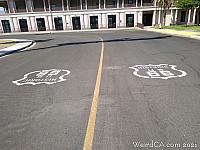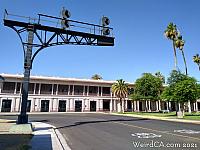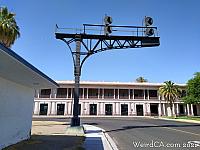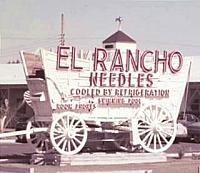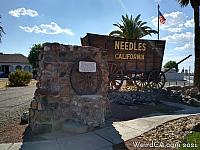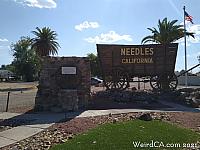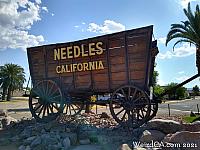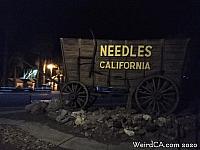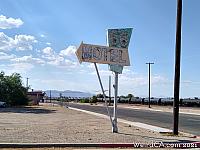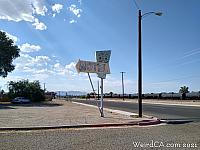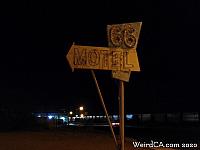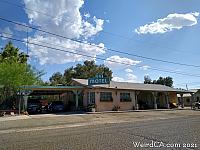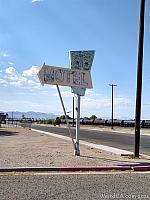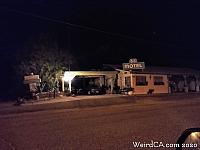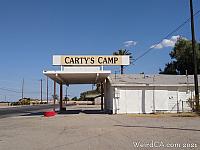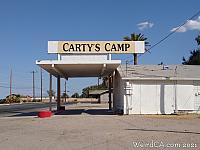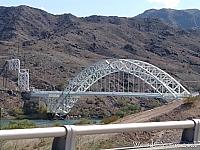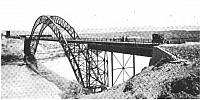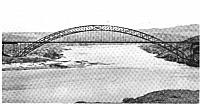Route 66 Needles
 Military Monuments
Military Monuments
Route 66,
Needles, California
92363
 El Garces Hotel
El Garces Hotel
149 G Street #101,
Needles, California
92363
 Borax Wagon
Borax Wagon
W Broadway Street,
Needles, California
92363
 66 Motel
66 Motel
91 Desnok Street,
Needles, California
92363
Needles is the last city on Route 66 before leaving California and entering Arizona. It is also next to Nevada. Since most of Route 66 east of Barstow consists of ghost towns, there's about 140 miles of empty desert separating the two cities. The town was founded in May of 1883 and incorporated on October 30th, 1913. In 2008, the town tried moving from California to Nevada, and also considered joining Arizona as a possibility. Regardless, Needles is still part of California. Needles is known for being one of the hottest towns in the nation. Here are just a few of the Route 66 attractions that can be found in this hot desert town.
Snoopy's brother, Spike, lives in the desert outside of Needles. Charles Schulz used to live in Needles when he was younger. You can find a statue of Spike inside one of the Subway restaurants. There is also a mural featuring him.
Rock Pile Monuments
West of Needles, along Route 66, you'll start passing several really awesome rock piles, each pile spelling out various words. These rock piles are monuments to various branches and organizations of the military and were created by Jim Nickel. He began working on them in 2010, with the first one meant to honor his wife. Rock piles spell out "Army", "Navy", the United States Marine Corp "USMC", the United States Air Force "USAF", along with others.
American flags are often placed on the rock piles, but sadly due to the desert winds, last about three weeks. In 2015, the Needles Downtown Business Alliance stepped in and helps the Nickel's maintain the rock pile monuments, especially with the expense of replacing the flags.
Harvey House
Back in the day when most people traveled by train, train stations were important and glamorous, made to present the city's best, especially in the area around the station, much like today's airports. The El Garces opened in 1908, named after Father Francisco Garces, who supposedly was the first European to cross the Mojave Desert. It was considered by most to be an amazingly beautiful building with excellent architecture, and was managed by the Fred Harvey Company making it the local Harvey House. Harvey Houses often had some of the finest services in town, and El Garces was no exception, often being described as one of, if not the best, hotel and restaurant in the Harvey House portfolio.
El Garces closed as a Harvey House near the end of 1949, mostly a result of the changes in travel, moving from a train based travel industry to an automobile based one. Santa Fe Railway offices took over part of the building, and they stayed until 1988, causing the entire building to then close when they relocated. The City of Needles bought the building in 1999 and it was listed in the National Register of Historic Places in 2002. Plans for the building including having it house a museum, visitor center, hotel and restaurant.
In front of the El Garces, in the road leading up to it is an old cantilever train signal. Supposedly it was the very last one located between Alburquerque and Los Angeles. It ended up relocated here in front of the former Needles Harvey House.
Old Cantilever Train Signal
This old "West Needles" cantilever signal, reportedly the last one between Albuquerque and Los Angeles was relocated to this site with funds raised by The Friends of Centennial in honor of the Needles Railroad Workers.
Special thanks to the BNSF Railroad and Marc Richards of the Needles Public Works Department.
Dedicated March 14, 2015
Needles Borax Wagon
At Broadway and A Street, you'll find the Needles Borax Wagon. This is a borax wagon with the words "Needles" and "California" written across it. Wagons like this were used to move borax from Death Valley and other mines to the railways back in the 1880s. The wagons were hitched up to eighteen mules and two horses, referred to as a Twenty Mule Team.
The wagon in Needles was made by the Studebaker Wagon company. It was used in filming a movie called "20 Mule Team" in the early 1940s. The wagon is also rumored to have been used in an old Ronald Reagan television show called "Death Valley Days". The wagon first showed up in Needles in 1947. It was, until 1962, also originally part of the now gone El Rancho Motel, advertising the hotel with the words:
El Rancho
Needles
Cooled by Refrigeration
Swimming Pool
Room Phones
This borax wagon No. 277. It was made by the Studebaker Wagon company. A wagon factory was being established at Mohave, California about 1880, and was used by Borax companies operating east of Mohave Railhead. 3 of the wagon wheels are Conestoga wheels and 1 is a Mohave wheel. The wagon was used in the filming of "20 Mule Team" staring Wallace Beery in the early 1940's. It was brought to Needles in 1947 where it stood in front of the El Rancho Motel until 1962. The wagon was given to the City of Needles by Mr. Alexander in May of 1962.
66 Motel
Before leaving Needles, there is the former neon sign for the former 66 Motel. Even recently this sign was lit, with a 2012 fundraising campaign allowing it to light back up with the 66 lit up in green and the "motel" lighting up in red. But when I visited, it was simply dark.
The 66 Motel was originally a six room motel opened in 1947 in Needles. Now, and since the 1990s, it is basically several studio apartments.
Across the street from the 66 Motel neon sign is Carty's Camp. Carty's Camp began in 1923 as Bill Carty's and Dick Mansker's Camp Ground and Service Station. Carty eventually bought out Mansker, renaming the location simply Carty's Camp. The location offered up both lodging in the form of cabins and mechanical services at the service station. At some point, there might have also been a cafe and a grocery story of some sorts as part of the complex. In the mid to late twenties, you might have also been able to purchase brand new automobiles from the location too. The business changed hands several times after World War II, and the service station was separated from the lodging at some point too.
Old Trails Arch Bridge
The original bridge over the Colorado River, for Route 66 at least, is referred to as the Old Trails Bridge, but has also gone by the Topock Bridge or the Needles Bridge. It is a steel arch bridge with a span of 600 feet and a length of 800 feet. It was completed on February 20th, 1916 and at the time was the longest, lightest arched bridge in America. Before its completion, motorists utilized a ferry service to get across the river. The paved roadway on the bridge was only seventeen feet wide, fairly narrow for a road. Route 66 used the bridge all the way until May 21st, 1947. At that time, Route 66 began using a repurposed truss bridge. Meanwhile, the Old Trails Bridge had its deck removed and was converted to carry a natural gas pipeline across the river. It ended up on the National Register of Historic Places in 1988. It also appears in the 1940 film adaptation of Grapes of Wrath.
The Red Rock Bridge was built in 1890 as a railroad bridge, but eventually it was converted to handle cars in 1947 and had Route 66 diverted over it. The bridge was eventually replaced in 1966 by the current Interstate 40 bridge and sadly demolished in 1978. It also saw traffic on it from 1914 when flooding caused an issue with the river ferry until the Old Trails Bridge's completion in early 1916.
The opening credits scene in Easy Rider show both bridges off to the right while Peter Fonda rides a motorcycle. The closer bridge is the Red Rock Bridge, and you can see the Old Trails Bridge on the other side of Red Rock Bridge. It looks like they are crossing on the newer California-Arizona Interstate Bridge.
The current bridge for Interstate 40 is the California-Arizona Interstate Bridge which is a deck plate girder bridge over the Colorado River. It was built in 1966.
Follow WeirdNV.com!
First Created: 2021-10-23
Last Edited: 2021-10-23



